2022 TOYOTA SUPRA airbag
[x] Cancel search: airbagPage 13 of 498

11
1
1-1. NOTES
NOTES
or the driver's behaviour.
These include, for example:
• Status reports relating to the
vehicle and its individual compo-
nents, for example wheel speed,
wheel circumferential velocity,
deceleration, lateral accelera-
tion, fastened seat belts.
• Ambient conditions, for example
temperature, rain sensor signals.
The data is processed within the
vehicle and is usually transient. It is
only saved for longer than the oper-
ating period if it is required in order
to perform services agreed with the
customer.
Electronic parts, for example con-
trol devices and vehicle keys, con-
tain components for storing
technical informat ion. Information
about the vehicle's condition, com-
ponent use and wear, maintenance
requirements, events or errors can
be stored temporarily or perma-
nently.
This information generally docu-
ments the condition of a compo-
nent, a module, a system or the
vehicle surroundings, including:
• Operating states of system com-
ponents, for examp le fill levels,
tyre inflation pr essure, battery
status.
• Malfunctions and faults of impor-
tant system components, for
example lights and brakes.
• Responses of the vehicle to par-
ticular driving situations, for
example triggering of an airbag,
activation of th e drive stability
control systems.
• Information on vehicle-damag-
ing events.
The data is required so that the
control units can perform their func-
tions. It is also used for detecting
and rectifying malfunctions, as well
as to optimise vehicle functions.
Most of this data is transient and is
only processed within the vehicle
itself. Only a small proportion of the
data is stored in event or error
memories in response to specific
circumstances.
Convenience functions, such as
seat, climate or light settings, make
every journey even more pleasant.
The personal settings for these
functions can be saved in a profile
within the vehicle and retrieved on
request, for example if the settings
have been changed by another
driver. Depending on the equip-
ment, these profiles can be saved
in the vehicle manufacturer's
secure data systems. When the
driver changes vehicle, these
saved profiles can simply be
applied to a different vehicle.
The vehicle settings saved in the
vehicle profile can be changed or
deleted at any time.
Electronic components
Personal settings
Page 15 of 498

13
1
1-1. NOTES
NOTES
only use this data for the purposes
of performing the service or repair
order in question. This prevents
work from being duplicated unnec-
essarily on the vehicle, for exam-
ple.
The data logs the technical condi-
tions of the vehicle and helps in
locating errors, complying with war-
ranty obligations and improving
quality.
To ensure product quality and the
development of new products, data
on the usage of individual compo-
nents and systems may be read
out, for example lights, brakes,
power windows, displays. This data
helps the vehicle manufacturer to
optimise the design of components
and systems. Data analysis also
provides the basis for Technical
Campaigns and statutory recalls.
Furthermore, the manufacturer has
product monitoring obligations to
meet in line with product liability
law. To fulfil these obligations, the
vehicle manufacturer requires tech-
nical data from the vehicle.
Data from the vehicle can also be
used to check customer warranty
claims. If goodw ill or warranty
claims are asserted, the read out
data is transferred to the vehicle
manufacturer to resolve the claims
promptly.
Error and event memories in the
vehicle can be reset when any
authorized Toyota retailer or Toyota
authorized repairer, or any reliable
repairer performs repair or servic-
ing work.
Data transferred to the vehicle
manufacturer for the purposes of
ensuring product quality or optimis-
ing service processes can be pre-
vented upon request.
According to current law, the vehi-
cle manufacturer is obliged to pro-
vide the authorities with any data it
has stored. Data is provided to the
extent required and on a
case-by-case basis, for example to
investigate a criminal offence.
The current law also gives state
bodies authorisation to read out
data from the vehicle themselves
for individual cases. This could
include reading out data from the
airbag control device to shed light
on the circumstances of an acci-
dent, for example.
In the context of legal obligations
within the EU, certain vehicle con-
sumption data, so-called OBFCM
data, are transmitted to the EU
Ensuring product quality
Goodwill and warr anty claims
Control over data
Legal requirements regard-
ing data disclosure
Page 23 of 498

21
1
1-1. NOTES
NOTES
The owner of a vehicle equipped
with an automatic emergency call
system and the eCall statutory
emergency call system has the
right to use the on-board eCall sys-
tem instead of the automatic emer-
gency call function.
For deactivation requests, contact
any authorized Toyota retailer or
Toyota authorized repairer, or any
reliable repairer.
The eCall statutory emergency call
system is always on standby in
addition to the automatic emer-
gency call system. The eCall statu-
tory emergency call system takes
over the emergency call function if
the automatic emergency call sys-
tem is not functional for technical
reasons, for example if the emer-
gency call centre appointed by the
vehicle manufacturer cannot be
reached.
The eCall statutory emergency call
system uses the infrastructure of
the 112 public emergency call num-
ber.
The system can be configured so
that emergency calls are always
made via the eCall statutory emer-
gency call system and not via the
automatic emergency call system.
Have the setting configured by any
authorized Toyota retailer or Toyota
authorized repairer, or any reliable
repairer.
This vehicle is equipped with an
event data recorder EDR. The main
function of this EDR is to record
data in the event of crash or
near-miss situations, such as trig-
gering of an airbag or collision with
a road obstacle; this data helps to
understand how the vehicle's sys-
tems behaved. EDR serves to
record data for a short period, typi-
cally 30 seconds or less, relating to
driving dynamics and the vehicle's
safety systems.
The EDR installed in this vehicle is
used for recording the following
data:
The operating behaviour of vari-
ous vehicle systems.
Whether the driver and front-seat
passenger had fastened their
seat belts.
How far the driver had pressed
the accelerator and/or brake
pedals, if at all.
What speed the vehicle was trav-
elling at.
This data can help to gain a better
understanding of the circumstances
leading to crashes and injuries.
EDR data is only recorded by the
vehicle if there is a severe accident;
under normal driving conditions, no
data is recorded by the EDR and no
personal data is saved either, for
example no data about name, gen-
der, age or accident location.
Statutory emergency call systemEvent data recorder EDR
Page 51 of 498
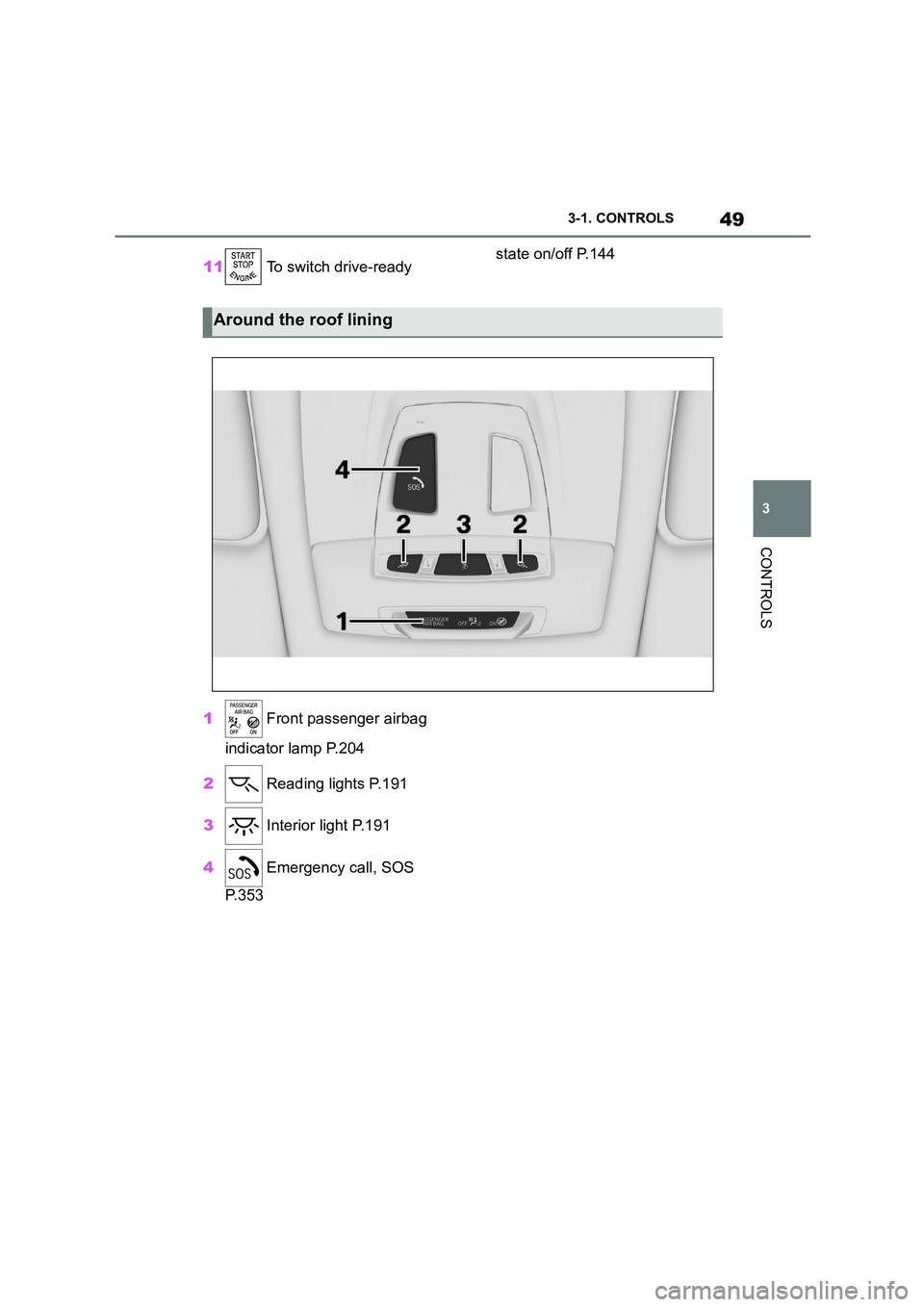
49
3
3-1. CONTROLS
CONTROLS
11 To switch drive-ready state on/off P.144
1 Front passenger airbag
indicator lamp P.204
2 Reading lights P.191
3 Interior light P.191
4 Emergency call, SOS
P. 3 5 3
Around the roof lining
Page 96 of 498
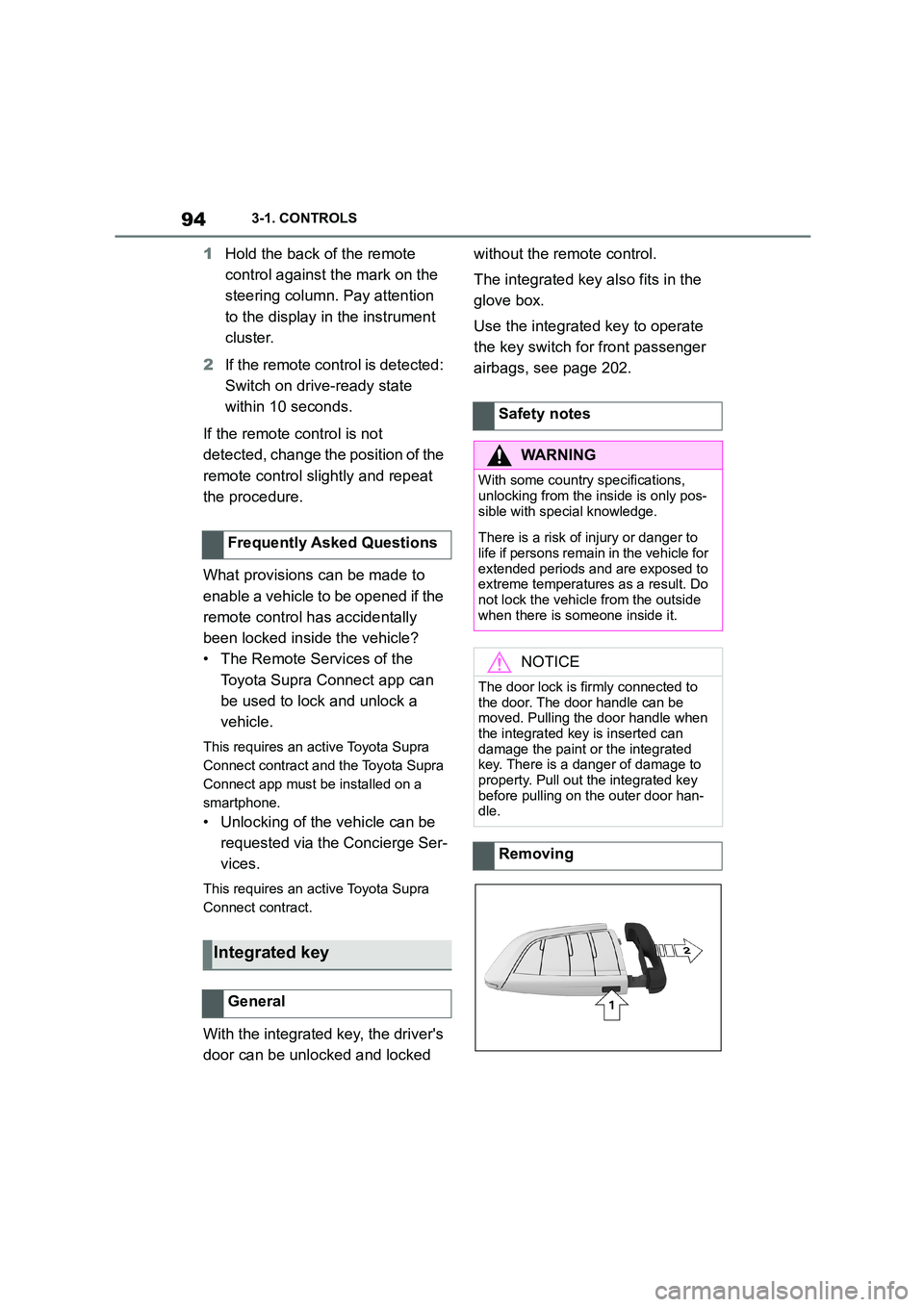
943-1. CONTROLS
1Hold the back of the remote
control against the mark on the
steering column. Pay attention
to the display in the instrument
cluster.
2 If the remote control is detected:
Switch on drive-ready state
within 10 seconds.
If the remote control is not
detected, change the position of the
remote control slightly and repeat
the procedure.
What provisions can be made to
enable a vehicle to be opened if the
remote control has accidentally
been locked inside the vehicle?
• The Remote Services of the
Toyota Supra Connect app can
be used to lock and unlock a
vehicle.
This requires an active Toyota Supra
Connect contract and the Toyota Supra
Connect app must be installed on a
smartphone.
• Unlocking of the vehicle can be
requested via the Concierge Ser-
vices.
This requires an active Toyota Supra
Connect contract.
With the integrated key, the driver's
door can be unlocked and locked
without the remote control.
The integrated key also fits in the
glove box.
Use the integrated key to operate
the key switch for front passenger
airbags, see page 202.
Frequently Asked Questions
Integrated key
General
Safety notes
WA R N I N G
With some country specifications,
unlocking from the inside is only pos-
sible with special knowledge.
There is a risk of injury or danger to
life if persons remain in the vehicle for extended periods and are exposed to
extreme temperatures as a result. Do
not lock the vehicle from the outside when there is someone inside it.
NOTICE
The door lock is firmly connected to
the door. The door handle can be moved. Pulling the door handle when
the integrated key is inserted can
damage the paint or the integrated key. There is a danger of damage to
property. Pull out the integrated key
before pulling on the outer door han- dle.
Removing
Page 109 of 498
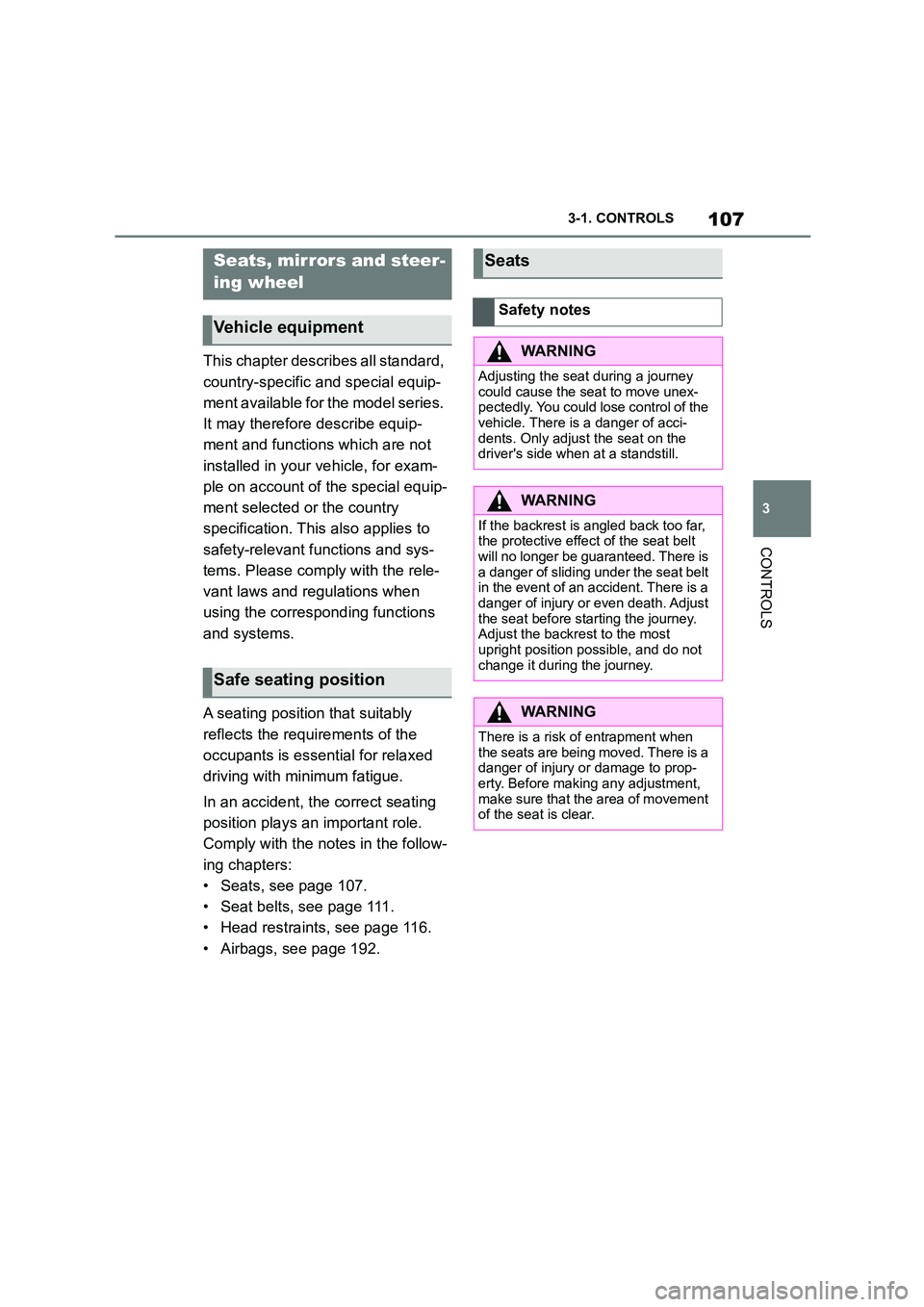
107
3
3-1. CONTROLS
CONTROLS
This chapter describes all standard,
country-specific and special equip-
ment available for the model series.
It may therefore describe equip-
ment and functions which are not
installed in your vehicle, for exam-
ple on account of the special equip-
ment selected or the country
specification. This also applies to
safety-relevant functions and sys-
tems. Please comply with the rele-
vant laws and regulations when
using the corresponding functions
and systems.
A seating position that suitably
reflects the requirements of the
occupants is essential for relaxed
driving with minimum fatigue.
In an accident, the correct seating
position plays an important role.
Comply with the notes in the follow-
ing chapters:
• Seats, see page 107.
• Seat belts, see page 111.
• Head restraints, see page 116.
• Airbags, see page 192.
Seats, mirrors and steer-
ing wheel
Vehicle equipment
Safe seating position
Seats
Safety notes
WA R N I N G
Adjusting the seat during a journey
could cause the seat to move unex-
pectedly. You could lose control of the
vehicle. There is a danger of acci- dents. Only adjust the seat on the
driver's side when at a standstill.
WA R N I N G
If the backrest is angled back too far,
the protective effect of the seat belt
will no longer be guaranteed. There is a danger of sliding under the seat belt
in the event of an accident. There is a
danger of injury or even death. Adjust the seat before starting the journey.
Adjust the backre st to the most
upright position possible, and do not change it during the journey.
WA R N I N G
There is a risk of entrapment when
the seats are being moved. There is a danger of injury or damage to prop-
erty. Before making any adjustment,
make sure that the area of movement of the seat is clear.
Page 113 of 498
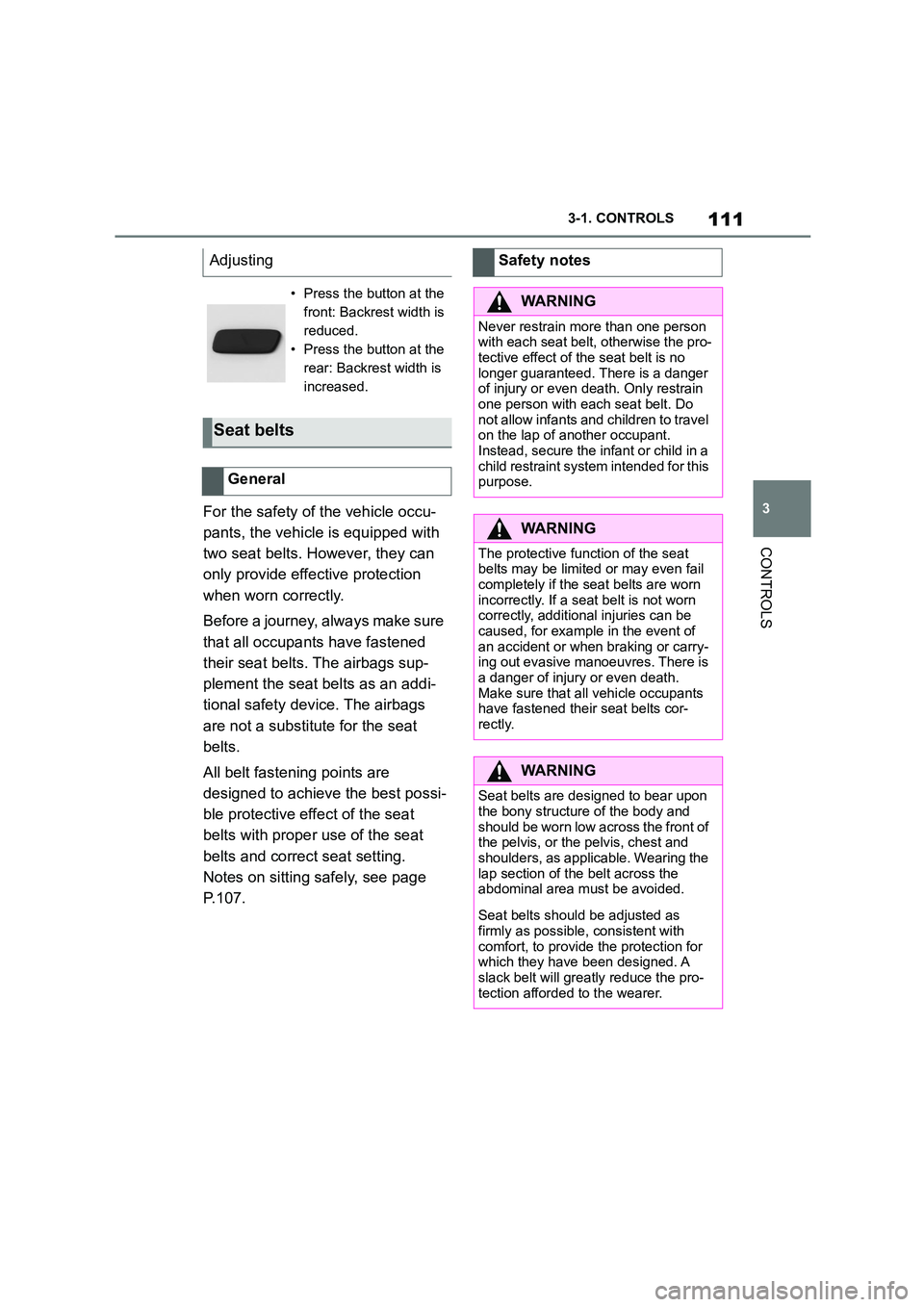
111
3
3-1. CONTROLS
CONTROLS
For the safety of the vehicle occu-
pants, the vehicle is equipped with
two seat belts. However, they can
only provide effective protection
when worn correctly.
Before a journey, always make sure
that all occupants have fastened
their seat belts. The airbags sup-
plement the seat belts as an addi-
tional safety device. The airbags
are not a substitute for the seat
belts.
All belt fastening points are
designed to achieve the best possi-
ble protective effe ct of the seat
belts with proper use of the seat
belts and correct seat setting.
Notes on sitting safely, see page
P.107.
Adjusting
• Press the button at the
front: Backrest width is
reduced.
• Press the button at the
rear: Backrest width is
increased.
Seat belts
General
Safety notes
WA R N I N G
Never restrain more than one person
with each seat belt, otherwise the pro- tective effect of the seat belt is no
longer guaranteed. There is a danger
of injury or even death. Only restrain one person with each seat belt. Do
not allow infants and children to travel
on the lap of another occupant.
Instead, secure the infant or child in a child restraint system intended for this
purpose.
WA R N I N G
The protective function of the seat
belts may be limited or may even fail
completely if the seat belts are worn incorrectly. If a seat belt is not worn
correctly, additional injuries can be
caused, for example in the event of an accident or when braking or carry-
ing out evasive manoeuvres. There is
a danger of injury or even death.
Make sure that al l vehicle occupants have fastened their seat belts cor-
rectly.
WA R N I N G
Seat belts are designed to bear upon
the bony structure of the body and
should be worn low across the front of the pelvis, or the pelvis, chest and
shoulders, as applicable. Wearing the
lap section of the belt across the abdominal area must be avoided.
Seat belts should be adjusted as firmly as possible, consistent with
comfort, to provide the protection for
which they have been designed. A
slack belt will greatly reduce the pro- tection afforded to the wearer.
Page 115 of 498
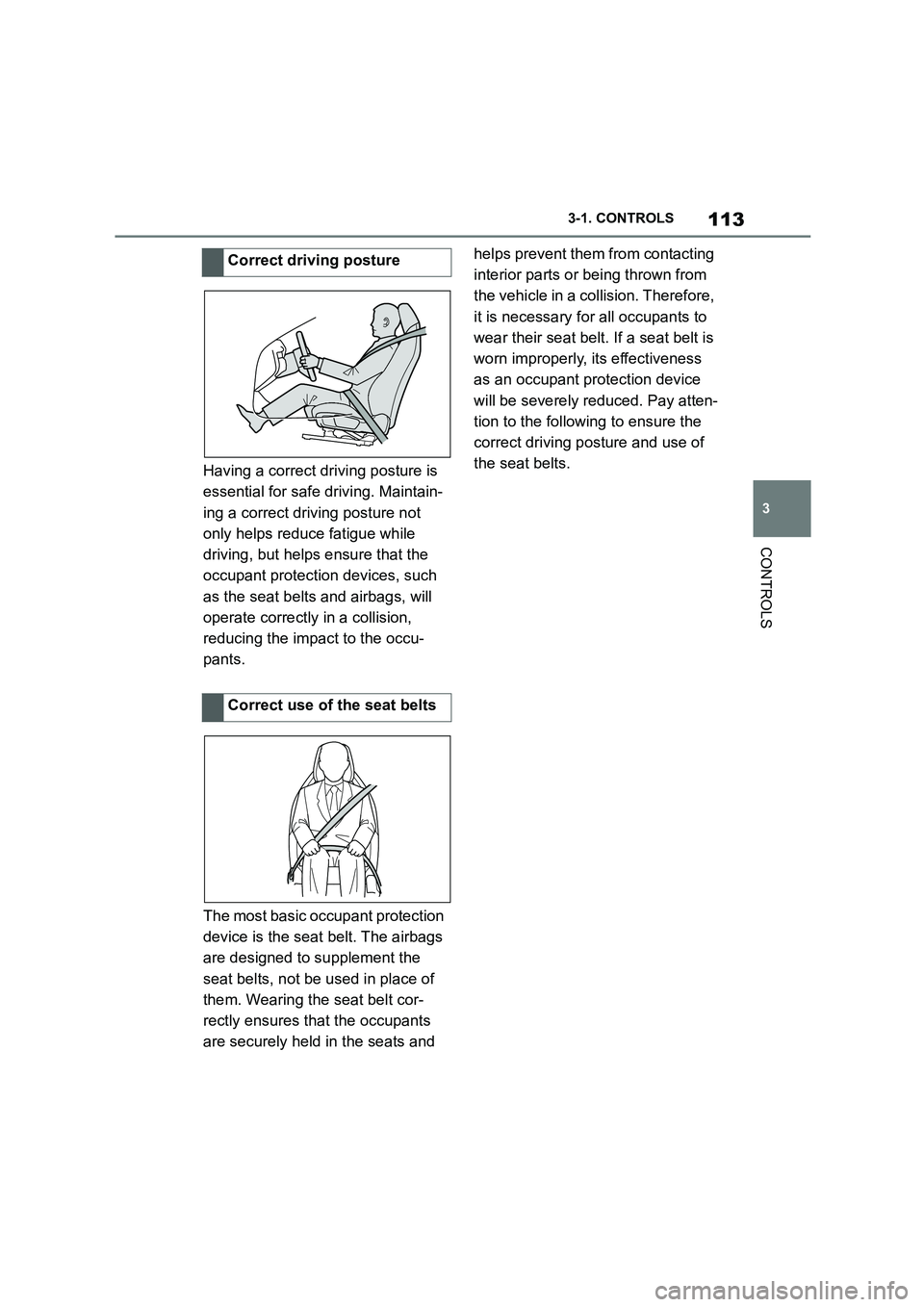
113
3
3-1. CONTROLS
CONTROLS
Having a correct driving posture is
essential for safe driving. Maintain-
ing a correct driving posture not
only helps reduce fatigue while
driving, but helps ensure that the
occupant protection devices, such
as the seat belts and airbags, will
operate correctly in a collision,
reducing the impact to the occu-
pants.
The most basic occupant protection
device is the seat belt. The airbags
are designed to supplement the
seat belts, not be used in place of
them. Wearing the seat belt cor-
rectly ensures that the occupants
are securely held in the seats and
helps prevent them from contacting
interior parts or being thrown from
the vehicle in a co llision. Therefore,
it is necessary for all occupants to
wear their seat belt. If a seat belt is
worn improperly, its effectiveness
as an occupant protection device
will be severely reduced. Pay atten-
tion to the following to ensure the
correct driving posture and use of
the seat belts.
Correct driving posture
Correct use of the seat belts